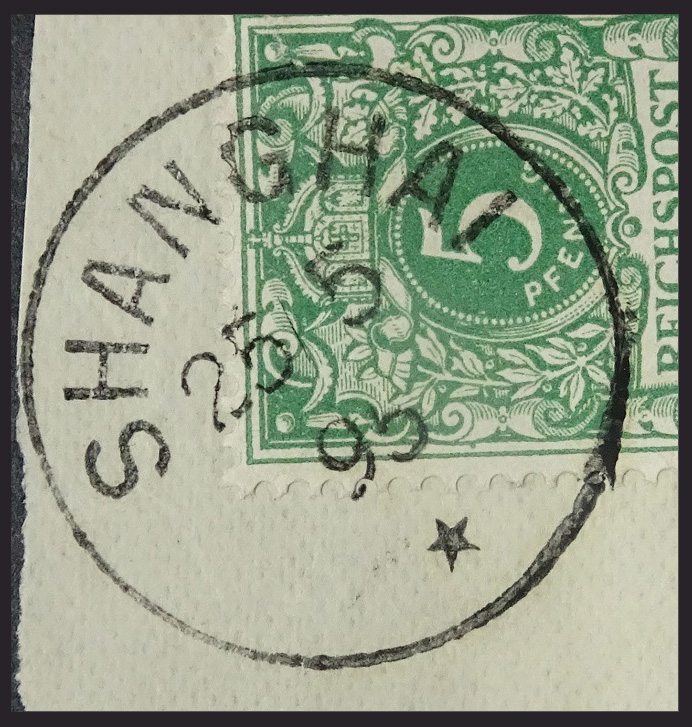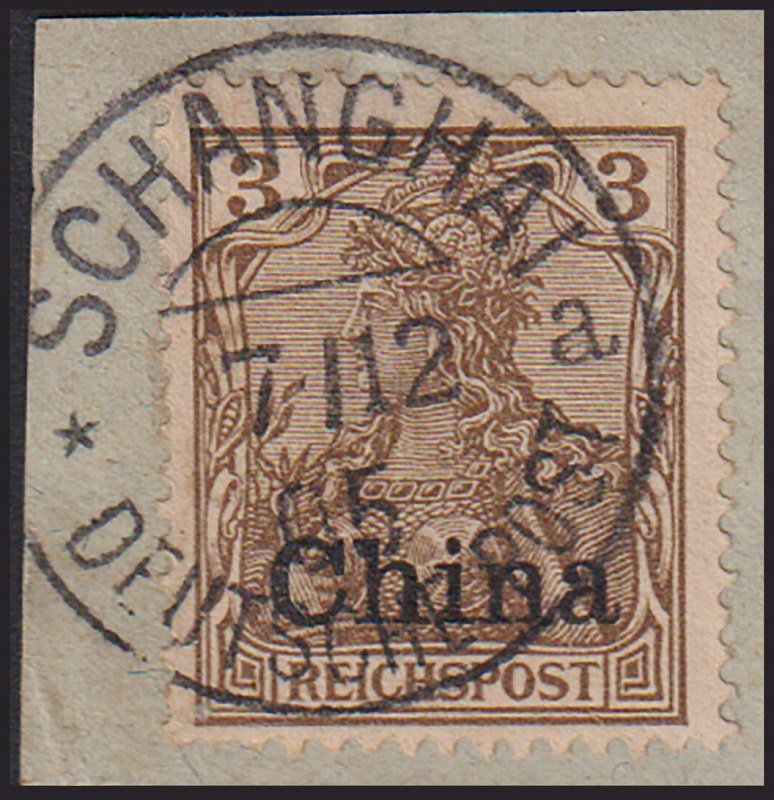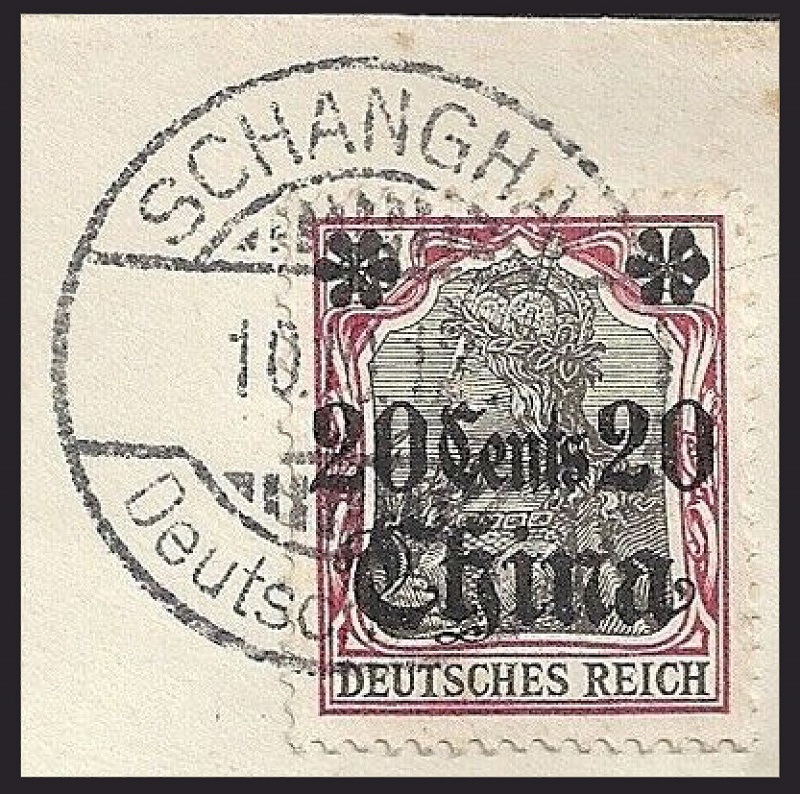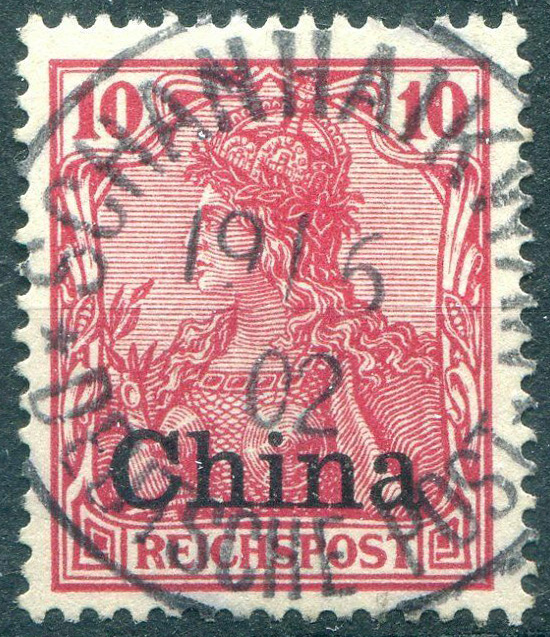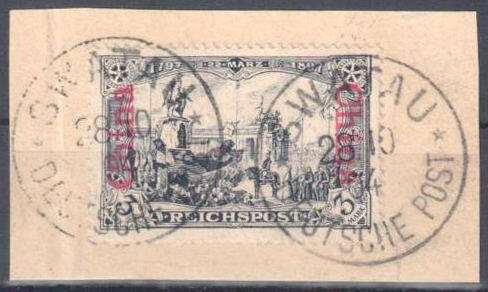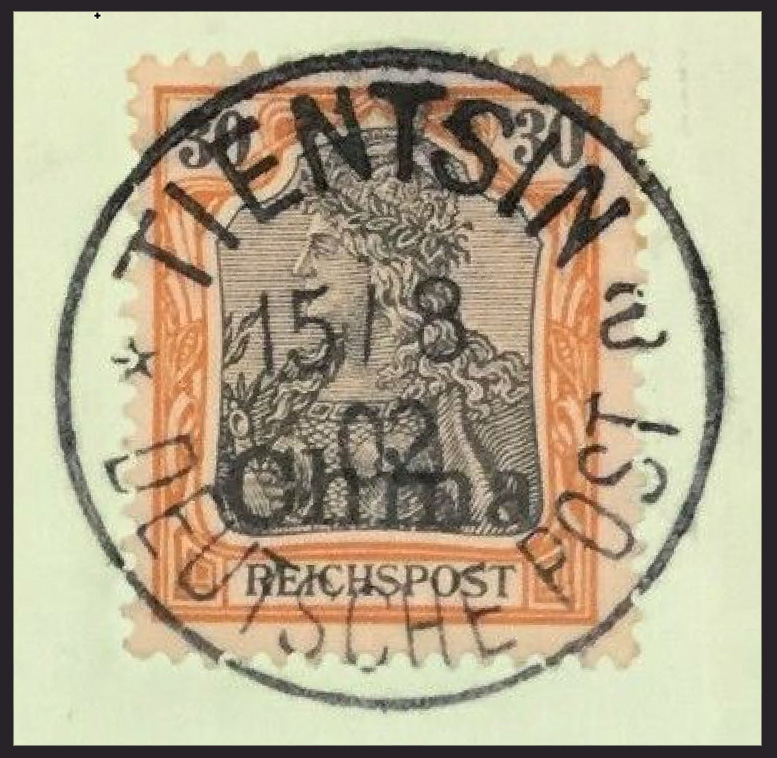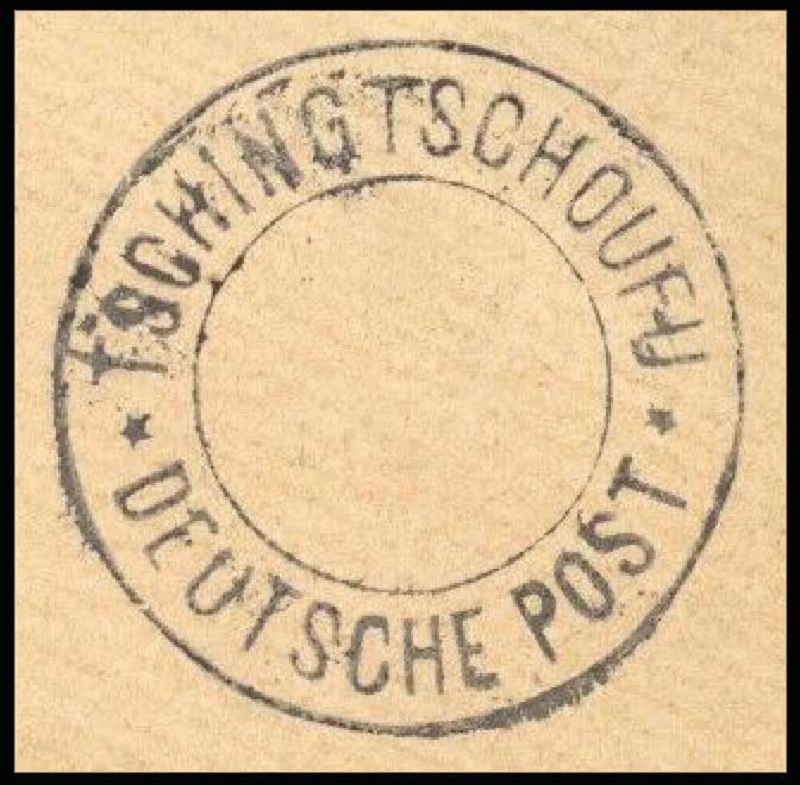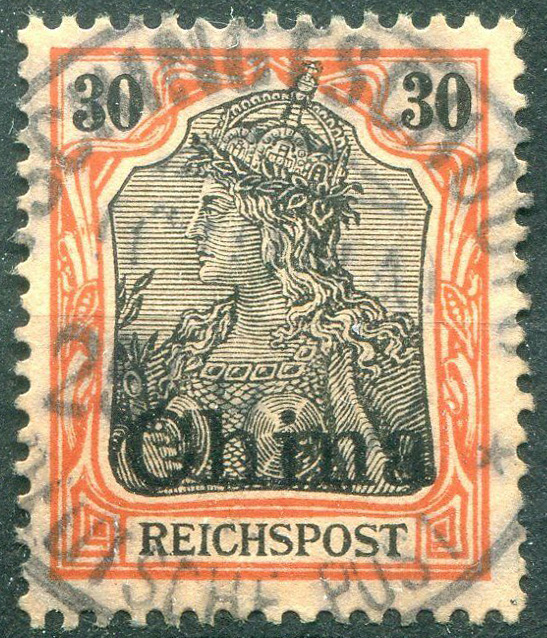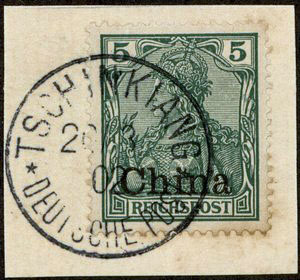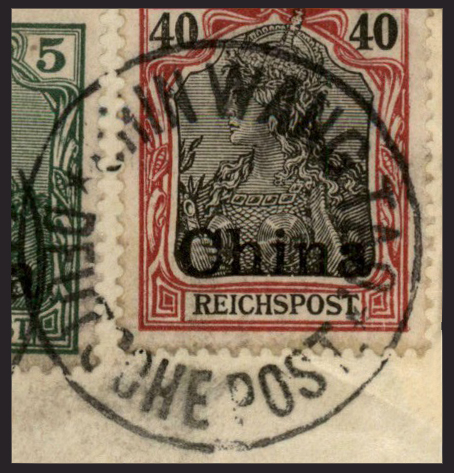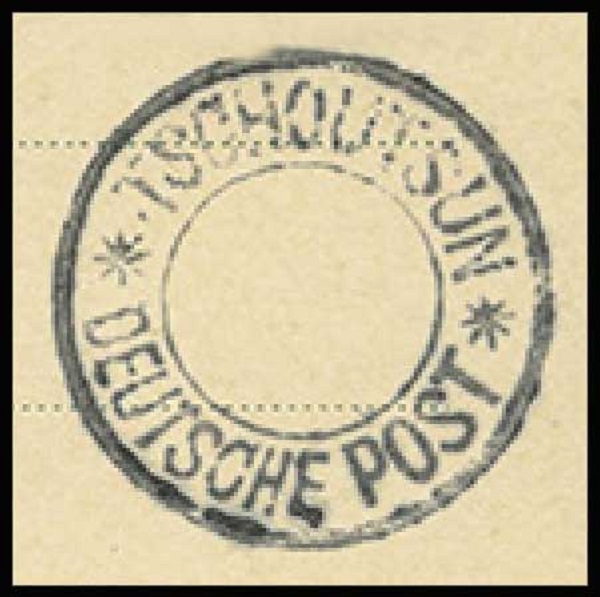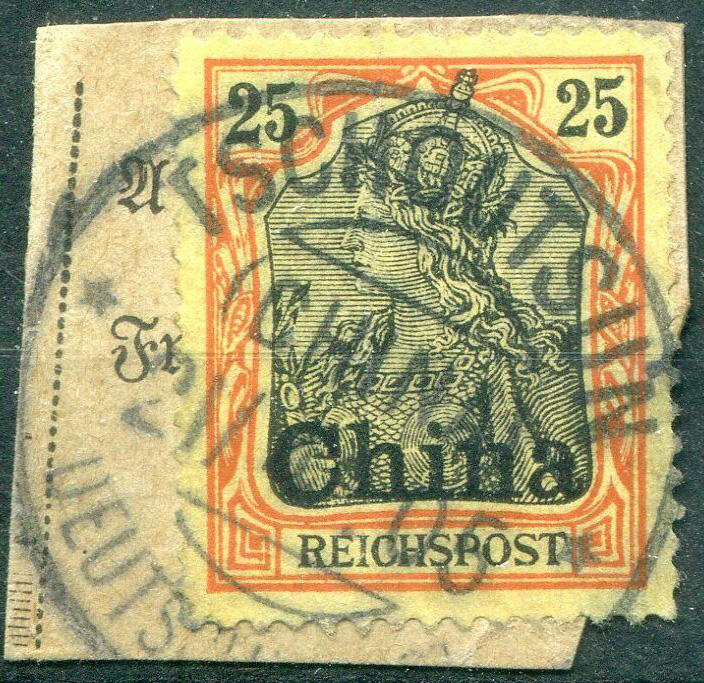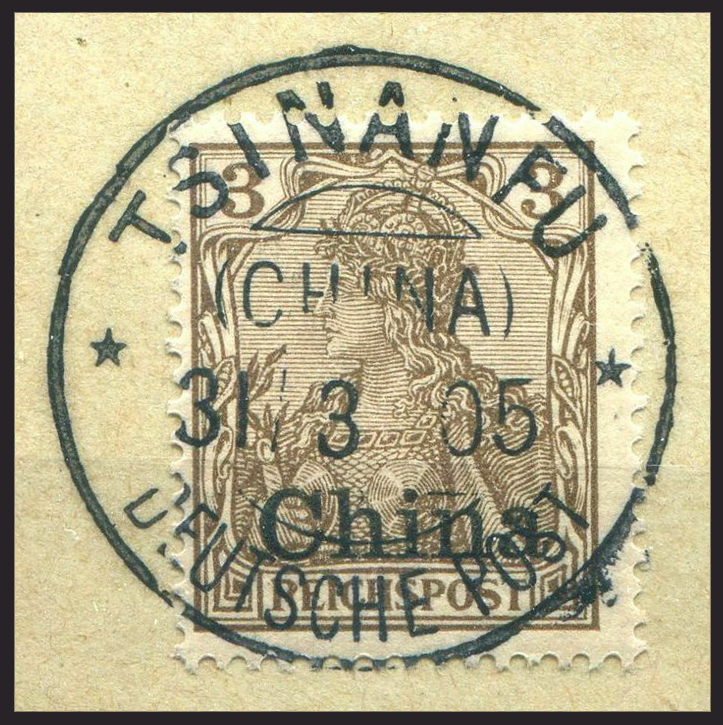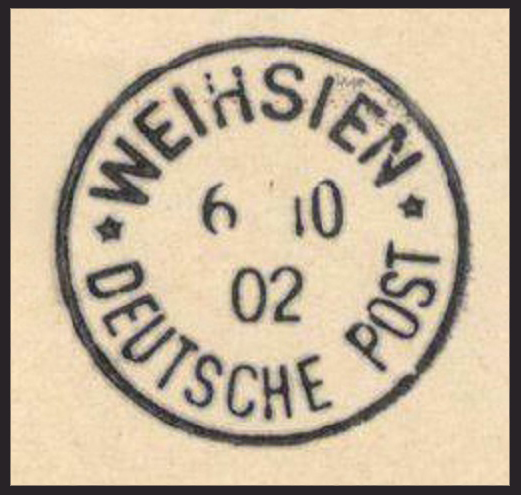GERMAN POST OFFICES ABROAD
CHINA

In terms of its colonial empire, Germany came relatively late on the scene. The German states had only become united in 1871 and by that time most of the western powers including Britain, France, Belgium and the Netherlands already had extensive overseas possessions. The Germans, wanting a seat at this privileged table, scrambled for whatever territories remained. By the 1880's the only region left that hadn't already been carved up was China and a few scattered islands in the Pacific as well as parts of Africa.
AMOY
(12th Jun 1902 - 16th Mar 1917)
Amoy was the traditional name for the modern city of Xiamen, in south-eastern Fujian province, opposite the Taiwan Strait. In the 1870's the city had a population of about 250,000 who used the local, unofficial Hokkien dialect in everyday speech. The British were the first to make an impact on Xiamen and due to their success in achieving preferential trade deals with the Chinese other European nations moved in, bringing with them Christianity and missionaries which caused much resentment in the local population. (1)
'AMOY | DEUTSCHE POST'
12th Jun 1902 to mid 1913
'AMOY | DEUTSCHE POST'
12th Jun 1902 to mid 1913
(2)
'AMOY | (CHINA) | DEUTSCHE POST'
mid 1913 to 16th Mar 1917
'AMOY | (CHINA) | DEUTSCHE POST'
mid 1913 to 16th Mar 1917

FUTSCHAU
(18th Jun 1900 - 16th Mar 1917)
Futschau or Fuzhou (or Foochow), is located in Fujian province in Southeast China. During the 1850's the city was a popular destination for Christian missionaries and in 1860's the French built a large port and naval academy. (1)
'FUTSCHAU | DEUTSCHE POST'
18th Jun 1900 to 16th Mar 1917
'FUTSCHAU | DEUTSCHE POST'
18th Jun 1900 to 16th Mar 1917

HANKAU
(1st Apr 1900 - 16th Mar 1917)
Hankau is now know as Wuhan and is located in Hubei province in eastern China. By 1900, Hankau, the Yangtze River boom town, was known as "the St. Louis and Chicago of China". (1)
'HANKAU | DEUTSCHE POST'
24th Apr 1900 to 16th Mar 1917
'HANKAU | DEUTSCHE POST'
24th Apr 1900 to 16th Mar 1917
(2)
'HANKAU'
1st to 30th Apr 1900
'HANKAU'
1st to 30th Apr 1900
(3)
Chinese Characters
with or without handwritten date
Chinese Characters
with or without handwritten date
(2) exists with or without a handwritten date.
(3) this additional handstamp contains Chinese characters as is known only as a favour cancel usually with a later cancel date.

ITSCHANG
(21st Feb 1903 - 1st Sep 1908)
Itschang (now known as Yichang), is a city located in western Hubei province, China. It is the second largest city in the province after Hankau (Wuhan). The city lies on the Yangtze River and is located close to the Qing River.


(1)
'ITSCHANG | (CHINA) | DEUTSCHE POST'
21st Feb 1903 to 1st Sep 1908
'ITSCHANG | (CHINA) | DEUTSCHE POST'
21st Feb 1903 to 1st Sep 1908

CANTON & KANTON
(2nd Jun 1902 - 16th Mar 1917 )
Canton, now known as Guangdong is located in Southern China on the South China Sea. At the end of the nineteenth century the region was a hotbed of anti-western activity, mainly due to its popularity with western immigrants and their privileged status, mainly gained at the expense of the local population. (1)
'CANTON | DEUTSCHE POST'
4th Jun 1902 to mid 1913
'CANTON | DEUTSCHE POST'
4th Jun 1902 to mid 1913
(2)
'KANTON | (CHINA) | DEUTSCHE POST'
21st May 1913 to 16th Mar 1917
'KANTON | (CHINA) | DEUTSCHE POST'
21st May 1913 to 16th Mar 1917

LANGFANG
Langfang is located approximately midway between Beijing and Tianjin. On 26th Jun 1900, during the Boxer Rebellion, European forces heading towards Beijing to relieve the besieged embassy district, were defeated at the Battle of Langfang by Chinese imperial forces supported by Boxer rebels and were forced to return to Tiensin. The European forces eventually relieved the city, defeating the Chinese forces at the Battle of Peking.Purple or black ink was used for this cancel and postage was free for feldpost during the Boxer Rebellion.



(1)
'POSTDIENSTST | S.B. | LANGFANG'
from 1st Sep 1901
'POSTDIENSTST | S.B. | LANGFANG'
from 1st Sep 1901
Mail items exist without this cancel but with 'LANGFANG' indicated in the sender's address (15th Jul 1901 to 1906). The origin is either Peking or Teintsin.
There are also examples of 'Langfang' being hand written on Registered labels and these originate in Tientsin from 15th Jul 1901 to 1906.

NANKING
(1st Jan 1903 - 16th Mar 1917)



(1)
'NANKING | (CHINA) | DEUTSCHE POST'
from 1st Jan 1903 to 16th Mar 1917
'NANKING | (CHINA) | DEUTSCHE POST'
from 1st Jan 1903 to 16th Mar 1917

NANLIU
The Nanliu cancel only occurs as an auxillery cancel.


(1)
'NANLIU | DEUTSCHE POST'
from 21st Mar to 1st Jun 1902
'NANLIU | DEUTSCHE POST'
from 21st Mar to 1st Jun 1902

PEITAIHO



(1)
'Peitaiho' indicated in sender's address
1st Sep 1901 to mid 1902
'Peitaiho' indicated in sender's address
1st Sep 1901 to mid 1902
(2)
'Peitaiho' indicated in sender's address
from mid 1902 to 1906
'Peitaiho' indicated in sender's address
from mid 1902 to 1906
(3)
'Peitaiho' handwritten on 'R-label' 1st Sep 1901 to mid 1902
'Peitaiho' handwritten on 'R-label' 1st Sep 1901 to mid 1902
(1) the origin for these items can be SHANHAIKUAN, SCHANHAIKWAN, TIENTSIN or TONGKU.
(2) the origin of these items can be TIENTSIN or TONGKU.
(3) 'Peitaiho' handwritten on 'R'-label, origin is either SHANHAIKUAN, SCHANHAIKWAN or TONGKU 1st Sep to mid 1902.

PEKING
(11th Sep 1900 - 15th Mar 1917)
(1)
'PEKING | DEUTSCHE POST'
soft-wood
11th Sep to 13th Nov 1900
'PEKING | DEUTSCHE POST'
soft-wood
11th Sep to 13th Nov 1900
(2)
'PEKING | DEUTSCHE POST'
hard-wood
11th Sep to 13th Nov 1900
'PEKING | DEUTSCHE POST'
hard-wood
11th Sep to 13th Nov 1900
(3)
'PEKING | DEUTSCHE POST'
14th Nov 1900 to 15th Mar 1917
'PEKING | DEUTSCHE POST'
14th Nov 1900 to 15th Mar 1917
(1) the soft-wood cancellation is determined by i) no dot between the 'S' and 'C' of 'DEUTSCHE'. ii) the first 'S' doesn't have a curved appearance compared to the hard-wood cancel. iii) shirt space between 'DEUTSCHE' and 'POST'. This cancel was also used as a Feldpost cancel during the Boxer Rebellion.
(2) the hard-wood cancellation is determined by i) a dot between the 'S' and 'C' of 'DEUTSCHE' (not always clear). ii) the first 'S' of 'DEUTSCHE' is well curved iii) there is a large space between 'DEUTSCHE' and 'POST'. This cancel was also used as a Feldpost cancel during the Boxer Rebellion.
(3) Used from 14th Nov 1900 until 15th Mar 1917 and as a Feldpost cancel during the Boxer Rebellion. This cancel also exists in violet ink in Nov 1900.
(4) There was also an official service cancel inscribed "STAB DER GESANDTSCHAFTSSCHUTZWACHE" used by the Occupation Brigade until 30th Apr 1906 and marine detachments until 30th Jun 1908.

SHANGHAI
(16th Aug 1886 - 16th Mar 1917)
The initial spelling on the cancel was Shanghai but from Apr 1905 it was changed to Schanghai. (1)
'KAISERLICH | DEUTSCHE POSTAGENTUR | SHANGHAI'
(KDPAg)
16th Aug 1886 to Jun 1894
'KAISERLICH | DEUTSCHE POSTAGENTUR | SHANGHAI'
(KDPAg)
16th Aug 1886 to Jun 1894
(2)
'SHANGHAI'
Jun 1894 to 5th Dec 1898
'SHANGHAI'
Jun 1894 to 5th Dec 1898
(3)
'SHANGHAI | a'
18th Jul 1898 to 1906
'SHANGHAI | a'
18th Jul 1898 to 1906
(3) was also used as a feldpost cancel during the Boxer Rebellion.
(4)
'SHANGHAI | DEUTSCHE POST | a'
1st Dec 1898 to 1908
'SHANGHAI | DEUTSCHE POST | a'
1st Dec 1898 to 1908
(5)
'SHANGHAI | DEUTSCHE POST | b'
1st Dec 1898 to 1908
'SHANGHAI | DEUTSCHE POST | b'
1st Dec 1898 to 1908
(6)
'SCHANGHAI | DEUTSCHE POST | a'
Apr 1905 to 16th Mar 1917
'SCHANGHAI | DEUTSCHE POST | a'
Apr 1905 to 16th Mar 1917
(4) and (5) was also used as a feldpost cancel during the Boxer Rebellion.
(7)
'SCHANGHAI | DEUTSCHE POST | b'
Apr 1905 to 16th Mar 1917
'SCHANGHAI | DEUTSCHE POST | b'
Apr 1905 to 16th Mar 1917
(8)
'SCHANGHAI | Deutsche Post'
May 1908 to 16th Mar 1917
'SCHANGHAI | Deutsche Post'
May 1908 to 16th Mar 1917
(9)
'DEUTSCHES LAGER | SHANGHAI'
private cancel used on authentic mail items
'DEUTSCHES LAGER | SHANGHAI'
private cancel used on authentic mail items
(8) after the post office was closed this cancel was also used briefly as an arrival cancel. Known usage dates are 21st and 27th Mar 1917.



(10)
'SHANGHAI | JAHR 20.4.99 MARKT | CLUB CONCORDIA'
private cancel used on authentic mail items
'SHANGHAI | JAHR 20.4.99 MARKT | CLUB CONCORDIA'
private cancel used on authentic mail items
There was also a "Beschadigt durch Brandunglück | im Postamt Shanghai" two line cancel which was damaged by a fire at the Shanghai Post Office. It exists as a rubber stamp and an adhesive label from 28th Feb to 3rd Mar 1901.

SHANHAIKUAN / SCHANHAIKWAN
(1st Sep 1901 - 31st Oct 1902)
From the opening of the post office on 1st Sep 1901 the cancel used the spelling SHANHAIKUAN, then from 1st Mar 1902 until the post office was closed on 31st Oct 1902 the spelling was chaned to SCHANHAIKWAN. (1)
'SHANHAIKUAN | DEUTSCHE POST'
without date
1st Sep to 30th Nov 1901
'SHANHAIKUAN | DEUTSCHE POST'
without date
1st Sep to 30th Nov 1901
(2)
'SCHANHAIKWAN | DEUTSCHE POST'
with date
1st Mar to 31st Oct 1902
'SCHANHAIKWAN | DEUTSCHE POST'
with date
1st Mar to 31st Oct 1902
(1) was also used as a feldpost cancel during the Boxer Rebellion.
(2) known to have been incorrectly cancelled '7.1.02' instead of '1.7.02'
NOTES:
(1) Mail from 1st Dec 1901 to 28th Feb 1902 with 'Schanhaikwan' indicated in the sender's address originates from CHIN WANG TAO or TSCHINWANGTAU.
(2) Mail from 1st Nov 1902 to 1906 with 'Schanhaikwan' indicated in the sender's address originates from TIENTSIN, TONGKU or TSCHINWANGTAU and may also have transferred through the Russian Postal Service in 1902.
(3) mail with 'Schanhaikwan' or 'Shanhaikuan' handwritten on the R-label from 1st Nov 1902 to 1905 originated in TONGKU or TSCHINWANGTAU.

SWATAU
(17th May 1904 - 16th Mar 1917)
(1)
'SWATAU | DEUTSCHE POST'
17th May 1904 to 16th Mar 1917
'SWATAU | DEUTSCHE POST'
17th May 1904 to 16th Mar 1917
(2)
'SWATAU | DEUTSCHE POST'
1st to 9th Jan 1905
'SWATAU | DEUTSCHE POST'
1st to 9th Jan 1905
(2) has a makeshift year slug that doesn't match the rest of the date slug.

TIENTSIN
(1st Apr 1893 - 16th Mar 1917)
The Teintsin post office was closed for a brief period from 17th to 25th Jun 1900 due to the unrest caused by the Boxer Rebellion. (1)
'TIENTSIN | KAISERL.DEUTSCHE | POSTAGENTUR'
(KDPAg)
1st Apr 1893 to Oct 1899
'TIENTSIN | KAISERL.DEUTSCHE | POSTAGENTUR'
(KDPAg)
1st Apr 1893 to Oct 1899
(2)
'TIENTSIN | DEUTSCHE POST | a'
15th Oct 1899 to 16th Mar 1917
'TIENTSIN | DEUTSCHE POST | a'
15th Oct 1899 to 16th Mar 1917
(3)
'TIENTSIN | (CHINA) | DEUTSCHE POST | b'
Sep 1902 to 16th Mar 1917
'TIENTSIN | (CHINA) | DEUTSCHE POST | b'
Sep 1902 to 16th Mar 1917
(2) was also used as a feldpost cancel during the Boxer Rebellion.
NOTES:
Prior to the opening of the Tientsin post office if 'Tientsin' is noted in the sender's address then the origin was most likely Shanghai.

TONGKU
Tongku was a provisional post office from 8th Sep 1900 until the opening of the main post office on 1st Nov 1900. Cancel (1) below was used during this provisional period but from the 1st Nov 1900 cancel (2) replaced it and was used continuously until the closure of the Tongku post office on 30th Apr 1906. (1)
'TONGKU | DEUTSCHE POST'
without date
from 8th Sep to 31st Oct 1900
'TONGKU | DEUTSCHE POST'
without date
from 8th Sep to 31st Oct 1900
(2)
'TONGKU | DEUTSCHE POST'
with date
1st Nov 1900 to 30th Apr 1906
'TONGKU | DEUTSCHE POST'
with date
1st Nov 1900 to 30th Apr 1906
(3)
'Etappe Tangku'
auxiliary cancel
'Etappe Tangku'
auxiliary cancel
(1) properly postally used only in early Sep 1900 on covers and must be validated with an accompanying verifiable postmark or with arrival date until 21st Oct 1900. Dates after that are considered philatelically inspired. This cancel was also used as a feldpost cancel during the Boxer Rebellion.
(2) This cancel exists in violet ink, almost always addressed to 'Huch' and was also used as a feldpost cancel during the Boxer Rebellion.
(3) Mail with this cancel in black or violet originates in Tientsin from 1st May 1906 to 8th Nov 1909.

TSCHIANGLING
This cancel was only used as an auxiliary cancel. (1)
'TSCHIANGLING | DEUTSCHE POST'
without date
'TSCHIANGLING | DEUTSCHE POST'
without date
(1) This cancel was used in TSINGTAU - KIATSCHOU from 14th Dec 1901 to 23rd Jan 1902 and TSINGTAU - KAUMI from 24th Jan to 21st Mar 1902.

TSCHIFU
(1st Jan 1900 - 16th Mar 1917)
(1)
'TSCHIFU | DEUTSCHE POST'
1st Jan 1900 to 16th Mar 1917
'TSCHIFU | DEUTSCHE POST'
1st Jan 1900 to 16th Mar 1917
(1) was also used as a feldpost cancel during the Boxer Rebellion.
NOTES:
Before the opening of the post office in Tschifu (1st Jun 1892), mail with 'Tschifu' in the sender's address would have originated in Shanghai. Between 1st Jun 1892 and 31st Dec 1899 (after the post office opened) mail with 'Tschifu' in the sender's address with forwarding of 'H.Sietas Co' and 'WM Pustau & Co.' likely also originated in Shanghai.

TSCHINGTSCHOUFU
(1st Sep 1903 - 31st Sep 1905)
(1)
'TSCHINGTSCHOUFU | DEUTSCHE POST'
without date
15th Jun to 31st Oct 1903
'TSCHINGTSCHOUFU | DEUTSCHE POST'
without date
15th Jun to 31st Oct 1903
(2)
'TSCHINGTSCHOUFU | (CHINA) | DEUTSCHE POST'
1st Nov 1903 to 31st Dec 1905
'TSCHINGTSCHOUFU | (CHINA) | DEUTSCHE POST'
1st Nov 1903 to 31st Dec 1905

TSCHINKIANG
(28th Oct 1901 - 16th Mar 1917)
(1)
'TSCHINKIANG | DEUTSCHE POST'
28th Oct 1901 to 16th Mar 1917
'TSCHINKIANG | DEUTSCHE POST'
28th Oct 1901 to 16th Mar 1917

CHIN WANG TAO / TSCHINWANGTAU
(1st Dec 1901 - 10th Mar 1906)
Upon opening of the post office the CHIN WANG TAO, then on 15th Jan 1902 it was changed to TSCHINWANGTAU. This post office was only open in the winter months from Dec to Feb and ocasionally until early Mar. (1)
'CHIN WANG TAO | DEUTSCHE POST'
no date
1st Dec 1901 to 30th Jan 1902
'CHIN WANG TAO | DEUTSCHE POST'
no date
1st Dec 1901 to 30th Jan 1902
(2)
'TSCHINWANGTAU | DEUTSCHE POST'
15th Jan 1902 to 10th Mar 1906
'TSCHINWANGTAU | DEUTSCHE POST'
15th Jan 1902 to 10th Mar 1906
(1) This cancel can be found with a handwritten date and cancels from Tongku or Tschifu are also used alongside.
NOTES:
Mail with tschinwangtau in the sender's address from 1st Sep to 20th Nov 1901 most likely originated in Shanhaikuan.
During the temporary closure of the tschinwangtau post office from (??? to ???) mail with tschinwangtau in the sender's address would have originated from either Schanhaikwan, Tientsin or Tongku.
Mail with tschinwangtau handwritten on the R-label would have originated in either Schanhaikwan or Tongku.

TSCHOUTSUN
(15th Nov 1903 - 31st Dec 1905)
This post office was a railway post office and was used as an auxiliary cancel to Bahnpost cancels. (1)
'TSCHOUTSUN | DEUTSCHE POST'
no date
15th Nov 1903 to 15th Jan 1904
'TSCHOUTSUN | DEUTSCHE POST'
no date
15th Nov 1903 to 15th Jan 1904
(2)
'TSCHOUTSUN | (CHINA) | DEUTSCHE POST'
16th Jan 1904 to 31st Dec 1905
'TSCHOUTSUN | (CHINA) | DEUTSCHE POST'
16th Jan 1904 to 31st Dec 1905

TSINANFU
(16th Mar 1904 - 16th Mar 1917)
(1)
'TSINANFU | (CHINA) | DEUTSCHE POST'
16th Mar 1904 to 16th Mar 1917
'TSINANFU | (CHINA) | DEUTSCHE POST'
16th Mar 1904 to 16th Mar 1917

WEIHSIEN
(1st Jun 1902 - 1st Sep 1914)
(1)
'WEIHSIEN | DEUTSCHE POST'
1st Jun 1902 to Sep 1914
'WEIHSIEN | DEUTSCHE POST'
1st Jun 1902 to Sep 1914

YANGTSUN
Mail items with Yangtsun handwritten on the stamp itself probably originated from either Tientsin or Peking in 1901.Mail with Yangtsun in the sender's address from 17th Jul 1901 to 30th Apr 1906 originated in Tientsin or Peking.
Mail items with Yangtsun handwritten on the R-label from 17th Jul 1901 to 30th Apr 1906 originated in Tientsin.

MAIL ROUTED Via Alternative Routes
Mail from China to Germany was traditionally carried onboard ships and efforts were made to find alternative, and hopefully faster routes. There were a number of trials using overland routes via Siberia as well as another land route through Mongolia and sea routes via North America, however none of them were commercially successful as mail usually took longer than the traditional route via sea.via SIBERIA
There were 3 trials using a route from Tientsin, over Lake Baikal (frozen in winter) and then through Siberia to Germany. Unfortunately the transit time for mail via this route turned out to be significantly longer than the traditional sea route so it was suspended after the third trial.The first trial took place between Dec 1896 and Feb 1897, the second trial from Dec 1897 and Feb 1898 and the third and final trial from Dec 1898 to Feb 1899. Mail from these trials can be identified by a route endorsement such as 'Via Shanghai - Hongkong' or similar text.
Mail was carried via Siberia outside of these trials from Oct 1903 to Feb 1904 but with transit times from 3 to 4 weeks. In Feb 1904 this route was suspended due to the Russo-Japanese war and mail was again transferred by the traditional sea route.
In 1905 mail from the Northern Pechili area was also transported over the old Mongolian caravan route: Peking -> Kalgan -> Urge -> Kitchi, taking up to 4 or 5 weeks to arrive (up to 2 months in the winter). Mail sent via this route can only be identified by the transition time from the departure and arrival postmarks.
From Feb 1907 to Jul 1914 mail sent using the Siberia route will have a 'via Siberia' route endorsement. These mail items are fairly common and the 'via Siberia' annotation may be handwritten. Alternative endorsements include 'via Dalny', 'via Dalny and Siberia', 'via Dairen (Dalny) Siberia' as well as others. Mail could also transit via Siberia to the US or the Middle East and Egypt.
Jan to Mar 1911 saw an outbreak of plague in Mongolia which forced the re-routing of mail through Dairen-Mukden to Shanghai and Vladivostok with a transit time of around 25 days instead of the usual 15 to 17 days. Mail sent via this route can only be determined by the transit time and examining the cancellation dates.









